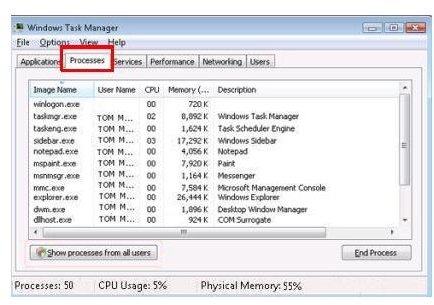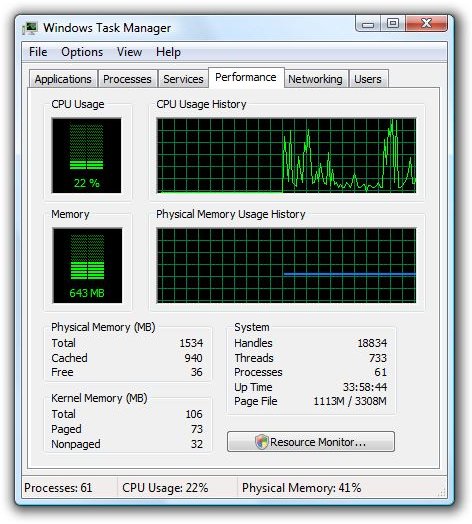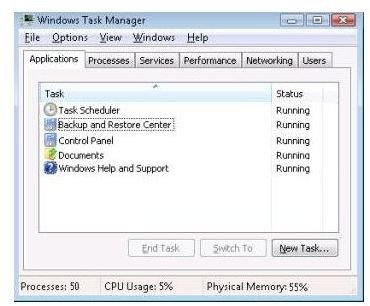How to Monitor Windows Vista Task Manager & Resource Usage - Keep Your Vista PC Running Fast
The more “stuff” you have running, the more system resources are taken up on your computer. It is important to keep track of the processes, programs, and services that load and run in the background each time you boot up. Keeping track of them, and getting rid of those that you don’t need will provide Vista with the maximum possible memory and processor cycles. Vista’s task manager, which comes with even more features than any other version of Windows, is a great tool to use for this purpose.
Tip #7: Regularly Monitor Your Task Manager
Use Vista’s Task Manager to monitor the processes, programs and services that are running on your PC at any given time. Using the different tabs on the Task Manager, you can:
- Determine which programs or processes guzzle system resources.
- Monitor any programs that frequently access your hard disk.
- End any processes or programs that you don’t need.
The Applications Tab
The Applications tab in Vista operates much the same as it does in XP. It displays the current status of the programs that you currently have running on your computer. It also enables you to end, switch to, or start a program as needed.
The Processes Tab
The Processes tab provides a listing of processes that are currently running on your computer under your user account, along with a brief description of each process. It also provides information on the CPU and RAM usage of each one. You can, for example, determine the real-time, percentage use of CPU and RAM resources that are taken up by a particularly resource-intensive program. Here’s how:
How to Find Out the Size and Location of a Running Process
- Click on the Processes tab.
- Right-click on the process.
- Select either the Open File Location or Properties option from the drop-down menu.
- Selecting the Open File Location option opens the directory (folder) that contains the process.
- Selecting the Properties option opens the Properties dialog box with information on the size, location and other information on the properties of that process.
- Click on the Details tab for even more detailed information on the particular process.

How to Use the View Menu for More Descriptive Detail
- Click on the View and then click on the Select Columns command. This opens the Select Process Page Columns dialog box.
- Check the boxes next to each of the settings for which you want more descriptive detail.
- Click the OK button.
A column for each of the settings that you select will be added to the Processes tab. For example:
- Checking the Image Path Name setting will add a column that displays the full name and path to the file that is behind the running process.
- Checking the Command Line setting will add a column that displays the full command line that is used to launch the process, including the switches or parameters for launching it.

The Services Tab
The Services tab in Vista’s Task Manager is a new feature that is not available on any other Windows version. Use it to monitor the Services that are currently running on your PC. You can:
- View or modify services that are currently running on your PC.
- Start or stop a service.
- Enable or Disable the User Account Control (UAC) file and registry virtualization of a process.
- Enable or Disable the registry virtualization of a process.
The Performance Tab
Vista Task Manager Performance tab enables you to monitor your computer’s real-time CPU usage and physical memory usage. It provides both graphical displays, as well as statistical details on each of these system resources. It even has a counter that tracks and displays system uptime.

The Networking and Users Tabs
The Networking and Users tabs work in much the same way as they do in XP.
- The Networking tab enables you to view both network status as well as how your network is currently functioning.
- The User’s tab enables you to see which users are logged onto the system.
This post is part of the series: 14 Ways to Speed Up Vista
Concluding the series by Dianna Monda Dill, this part brings the final 14 tips to speed up Vista. She’s not exactly saved the best for last, but these are some that power-users, especially, will enjoy.
- 14 Ways to Speed Up Vista - Part 1 - Create a Striped Volume
- Tip 2 & 3: Configure Your Vista Hard Drive For Advanced Performance
- Manually Adjust CPU Priority on Windows Vista
- Optimize or Disable Windows Search Indexing: Vista Tips
- Monitor Resource Usage Regularly on Your Vista Computer
- Use Vista Reliability and Performance Monitor
- Disable Excess Security Features on Windows Vista
- Tweak Windows Vista Network Settings
